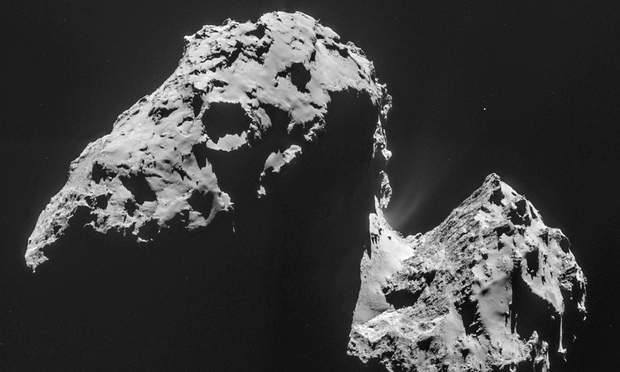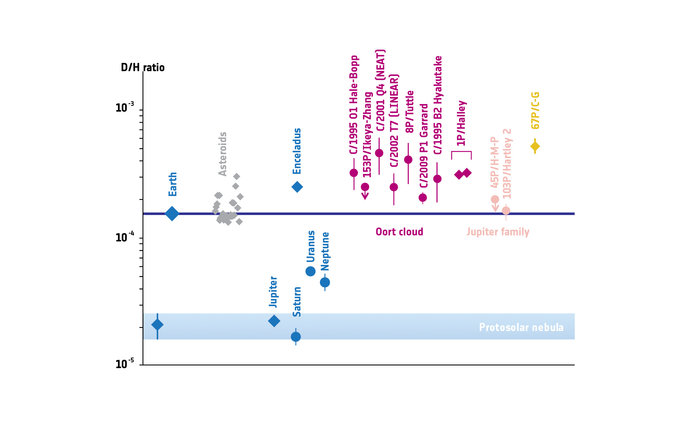December 11, 2014 – The analysis of data from Comet 67P/Churyumov-Gerasimenko indicates that water, at least from this comet, is not like water here on Earth. Rosetta has given us a preliminary picture of the comet’s composition with the water having significantly higher deuterium content than that found on Earth.
One reason Rosetta went in search of this particular comet was to probe into the early history of the Solar System to better understand Earth’s past. 67P, at the time, was considered a Kuiper Belt object that formed during the same period as the first protoplanets. It was thought, therefore, that the water ice it would contain would pretty much match that of Earth. But based on Rosetta findings 67P bears little resemblance to Earth when one looks at its water signature obtained by the spacecraft’s instrumentation.
67P it turns out has a water signature ratio of deuterium to hydrogen three times greater than the ocean water found on our planet. And its signature differs from other comets that fly within the same regions of the Solar System which may suggest that it did not originate in the Kuiper Belt at all. You can see the results plotted on the graph below. 67P stands far to the right (in yellow) while other Kuiper Belt comets (in purple) can be seen to be closer in affinity to Earth’s water signature.
What this tells us is that 67P may be an Oort Cloud object having originated from even further out on the very edge of the Solar System. Somehow its orbit was disrupted and it set off on a trip to the inner Solar System where influenced by Jupiter, it established an orbit that mimics those periodic comets originating from the Kuiper Belt.
The graph also shows that objects with water signatures closest to Earth appear to be asteroids. But the asteroids we see in the Solar System today, say scientists, are not that water rich. Kathrin Altwegg, at University of Bern, one of the project leaders on Rosetta, believes that in fact early asteroids contained much more water than what we find out there in the Solar System today. It was these asteroids that bombarded our planet some 3.8 billion years ago helping to form our oceans. So maybe life on Earth hitched a ride and came here from one or more of these space rocks.
The European Space Agency (ESA) team are hoping they can corroborate these early values when Philae recharges its batteries. A second instrument on board the lander has the ability to study the water signature and give us readings. If this doesn’t happen than ESA will fly Rosetta through a jet of tail debris as the comet’s orbit brings it close enough to the Sun to sufficiently warm it so that material from the surface gets jetted into space. Then we will no for sure just how far out of this world 67P really is.





















The late iconoclastic astrophysicist Thomas Gold, probably best known for his strong advocacy of the notion of abiogenic origins of oil and natural gas, advanced a theory of planetary formation wherein most of the Earth’s water must have been created by reduction reactions between methane and oxide minerals. In the early stages of gravitational planetary formation, constant and huge heat producing bombardements would have produced a molten condition that would have broken down CH4 into excess hydrogen and CHx. (Most commercial hydrogen production is through steam-reforming of methane.) Much of the hydrogen would have then combined with the oxygen in CO2 and mineral oxides, thus producing oceans of water and subterranean hydrocarbons chains. The present mass of methane in the gas-giant planets, Jupiter, Saturn, Uranus, and Neptune, vastly exceeds the entire mass of Mars, Earth, Venus, and tiny Mercury combined. Seems plausible a tremendous amount of methane was present in the initial accretion of material of Earth. Where is all that methane today?
One should be cautious in dismissing Gold’s uncommon perspectives. Gold was a scientific genius of the first water. In his foreword to Gold’s book The Deep Hot Biosphere, theoretical physicist Freeman Dyson stated, “Gold’s theories are always original, always important, usually controversial – and usually right.”